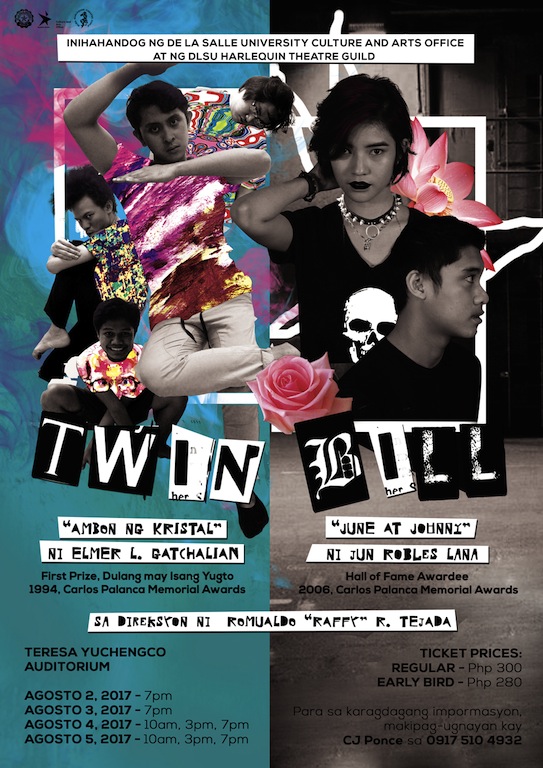
REVIEW: DLSU Harlequin’s Twin Bill is a powerful discourse on youth issues
Today, everything just rings on and on about social issues—even art, even theater. The youth, in particular, had been growing more keen by the day, expressing whatever they feel strongly about through any medium available to them. Two of these issues, drug addiction and teenage pregnancy, received the DLSU Harlequin Theatre Guild treatment with the socially relevant ‘Twin Bill’, featuring Elmer Gatchalian’s ‘Ambon Ng Kristal’ and Jun Robles Lana’s ‘June at Johnny’.
This production of the two Palanca Award-winning one-acts aptly showcase the ensemble’s youthful brashness overflowing at the seams. Helmed by esteemed thespian Romualdo “Raffy” Tejada, the production took off with its masterful direction and astounding technicals, but failed to come full circle with its oft intense performances, overlooking the subtleties the material originally provided.
Psychedelic theatricals in ‘Ambon ng Kristal’
Originally intended as an anti-drug one-act play, its timely staging this year adds an extra dimension with the ubiquitous issue that is President Duterte’s ongoing drug war. The material, however, written more than two decades ago, fail to directly address today’s situation. Still, the same voices drowning in their addiction echo in the present, still pleading to be heard.
The play revolved around a Filipino teenager, named Dennis, struggling with his drug addiction, his narrative interspersed with stories of each of his friends. Back stories are coupled with the numerous drugs they’ve tried along the way, setting the tone of each arc. All throughout, unsolicited voices drown the teenager, consistently tuning him out his own story. The story ended up asking, “How late is too late?”
Working with an almost bare stage, Tejada’s direction successfully transformed the ensemble themselves into dynamic set pieces. However, missed cues, like in choreography requiring the cast’s absolute simultaneity, rendered some scenes not as powerful as they could’ve been. Nevertheless, evident is Tejada as a virtuoso in orchestrating the amateur cast in a strong albeit frantic performance.
The cast held nothing back, which is not always a good thing in theater. What could’ve been one of the most powerful student productions this year, with its very relevant theme, ended up looking less believable– overly fleshed out emotions and all. That said, the ensemble was still wholly promising, especially Luis Breva (who played young Dennis) and Sammy Arroyo (who played Dennis’s OFW father), who stood out from the rest of the cast.
Where the cast lacked nuance, the stunning lighting design by Roman Cruz stepped in and unified every element, drenching them in liquid, pristine emotion. The lighting, with its impeccable timing, bathed the stage in psychedelic wonder, fully engaging the audience in the play’s own world. The ensemble, who donned all-white costumes, served as a blank canvas for the differing hues and emotions every scene required. Brilliant technicals weren’t gimmicky at all; instead, it helped retain the power of the production all throughout.
R&J and teenage pregnancy in ‘June at Johnny’
This second play tackles the fickleness of teenage love: the immaturity, the libido, and the repercussions of unplanned pregnancies. Set against the backdrop of a high-school production of Romeo and Juliet, the story unravels, drawing parallels as both are tragedies in their own right.
June’s and Johnny’s rashness mirrored Romeo’s and Juliet’s immaturity in the one-act. It emphasized the two character’s faults in an ingenious manner, by placing two key scenes from the Shakespearean classic at the beginning and end of the play. This over-imposition of the popular tragedy, however, could have been shorter than it was. Its lengthy verbatim excerpts at the beginning and end could have been sized down to not blunt the play’s own soul.
Tejada’s approach on ‘June at Johnny’ wasn’t as powerful as the first of the ‘Twin Bill’. The light banter every now and then blunted the supposed fiery chemistry between the youthful leads. At best, it was thoroughly entertaining—its humor both its boon and bane.
The two leads, Bella Marasigan as June and Daniel Banta as Johnny, filled the stage with the wit and charm befitting of their adolescent roles. However, their performances fluctuated, filled with bravura in one scene and lacking believability in the next. Fortunately, the occasional ad-libs made everything a lot more hilarious than the play already was, and all the more entertaining. The two actors successfully took advantage of the script’s inherent humor to get their point across.
Unlike ‘Ambon’, the technicals of ‘June at Johnny’ wasn’t as clear-cut. The haphazard lighting made the transitions between scenes as confusing as they can get. In one scene, the shifting of POVs weren’t seamless due to the slightly uncoordinated changes in hue which accompanied them. However, at least, the simple stage design—consisting of a bed, some spare tires and scaffolding— did not overpower the cast, allowing them to be elevated (metaphorically and literally) instead.
In retrospect, its strength comes mostly from its small cast and the script’s witticisms. In the midst of the audience’s laughter, a strong argument against teenage pregnancy slowly took shape, highlighting its inescapable effects along the way.
———
At a time when staying socially informed is already the norm, the DLSU Harlequin Theatre Guild was still able to make a mark by doing a magnificent job bringing these two plays to the stage. With stunning theatricals, especially for a student production, ‘Twin Bill’ perfectly addressed two of today’s youth’s most pressing issues. It showed not only what student plays could be, but also what they should be.


